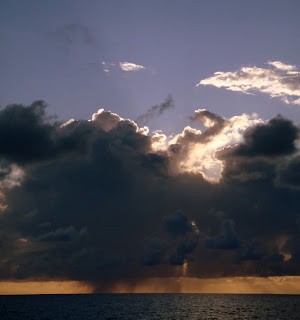This place is so busy and full of life! Our first week here has involved a few hurdles as we negotiate trying to readjust into "normal" life again.There has been ups and downs, much has happened and I'll briefly write about some of it here.
We sorted out local phone numbers and internet (the wireless internet here is so much faster and cheaper than what we had in Australia!!). Then, just as we'd become totally addicted to having fast, constant internet again, our modem melted!!! It took 2 days to sort out the problems from this as we had to find a new modem and put in both of our laptops for repair.
 |
| Jan and Rene at a local Indian restaurant. |
Nick and Jan from Yawarra 2 have been a great help - letting us have a few showers onboard their boat, letting us borrow their internet and shouting us out to our first meal here. Our taste buds have been getting a work out - after 3 months of relatively similar Indonesian food, we are now enjoying flavours from elsewhere. The Indian restaurant served up our meals on banana leaves and loud electronic music pumped out from the busy markets. We arrived just before Deepavali, the Indian festival of lights, but unfortunately missed out on the celebrations due to a mix up with dates.
The marina in Danga Bay is free because a rich Malaysian man simply wanted to own it as a status symbol. The problem with it being free however, is that there is no money for maintenance. The water wasn't running in the women's toilets yesterday and the shower head and pipe for the men's shower is missing. There is a stray cat with a bunch of kittens that lives here and every time I see it, it's peeing or pooing on the pathway. Right next to the marina is a small theme park complete with rides and money-wasting stalls. One night we went out with some Kiwi yachties and very nearly got on the pirate ride but figured it was a rip off at 10RM each (about $3.50 each). The water here is very dirty. With each change of tide, more rubbish floats past. The worst of it was when a giant sausage floated down from the reclamation site upstream to wrap itself around Anima! Nick and Jan zipped over in their dinghy to help but it was stuck fast - being quite large and incredibly heavy. At the change of tide, we managed to get it off but couldn't move it away far enough to avoid getting us again. We pulled up anchor and the marina kindly allowed us into a berth early!
 |
| Anima and the giant sausage stuck around her bows. |
 |
| Nick, Jan and Rene all trying to move the giant sausage. |
In contrast to the pollution of Johor Bahru, Singapore is like a shining, green beacon of cleanliness and organisation. Our first visit was with friends Alicia, Andrew and Josephine who drove us over the causeway. It was so exciting to be in a real shopping centre again! Our special treats were eating real ice-cream and real milk. YUM!
 |
| REAL AUSTRALIAN MILK!!!!! |
We visited Raffles Marina and were amazed at the luxury compared to Danga Bay. There are multiple pools, spa's, waterslides and waterfalls, a gym and amenities like I've never seen before in any marina!!
Subsequent visits to Singapore have been via bus - or to be exact, three busses each way plus kilometres of walking. We originally planned to live in JB and commute across to Singapore each day for work. After making this trip a few times however, we've realised that it's not a very viable plan as it takes between 1.5 to 3 hours for each trip. Instead, the current plan is to move across to Singapore (I really want to live at Raffles but we are looking at other cheaper alternatives too) when we get jobs and working Visa's.
Our Australian friend Jodie moved to Singapore to work as a teacher in July this year. We met with her in the Arab quarter and enjoyed culinary delights such as real hummus, apple-cinnamon-milk and real coffee! We even visited a mosque and had to wear ridiculous large, hot blue gowns to cover our non-Muslim skin. We arrived just as a wedding was taking place and the friendly guides explained it all to us very enthusiastically.
 |
| Jodie and I at the mosque |
 |
| A Singapore street near Bugis MRT station |
 |
| Plenty of people in the MRT |
There's so much to write about and so much is happening but what I really need to be doing is applying for jobs....

































































